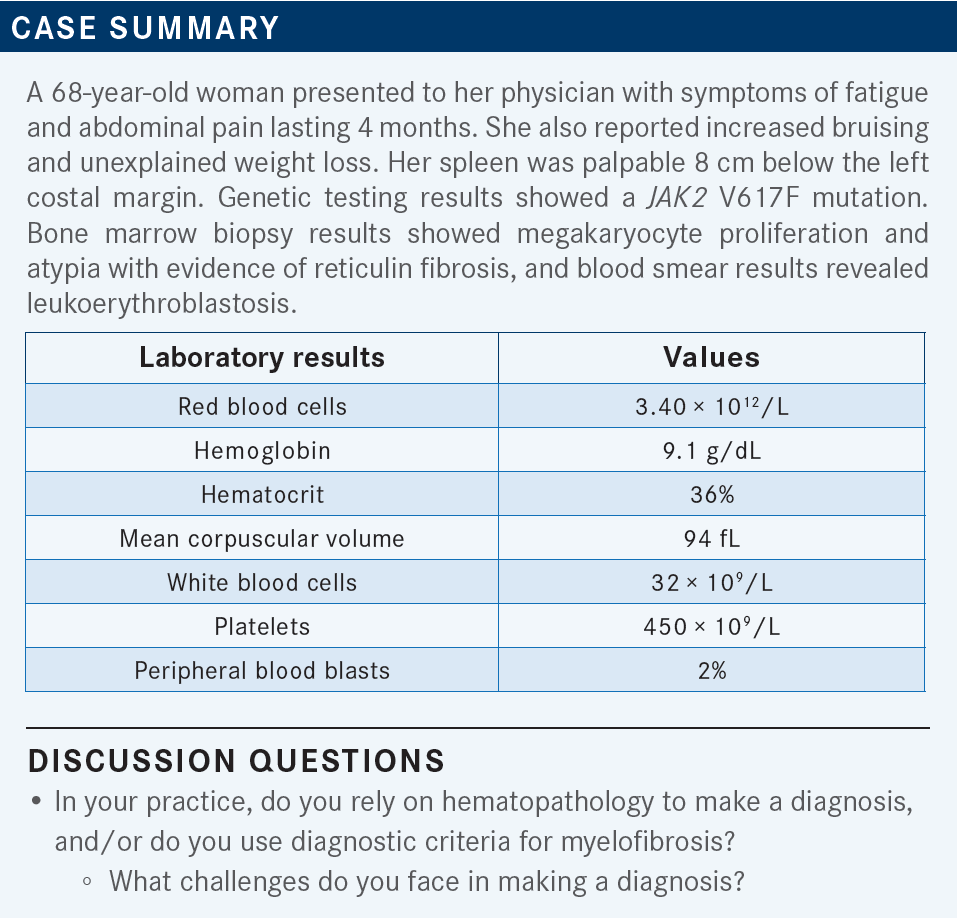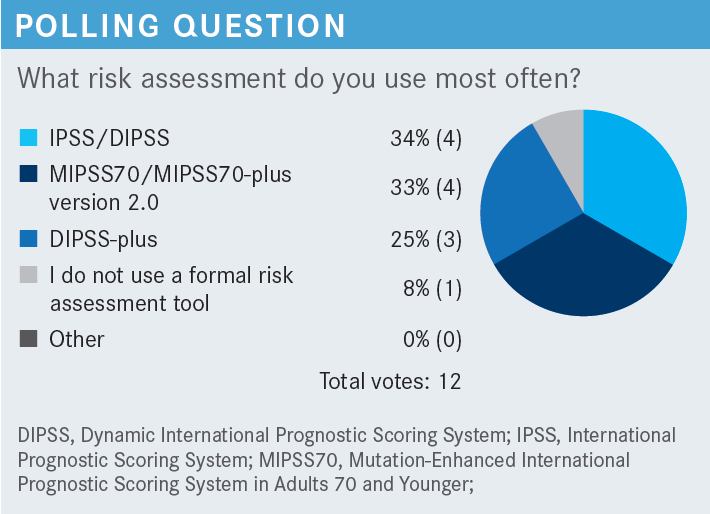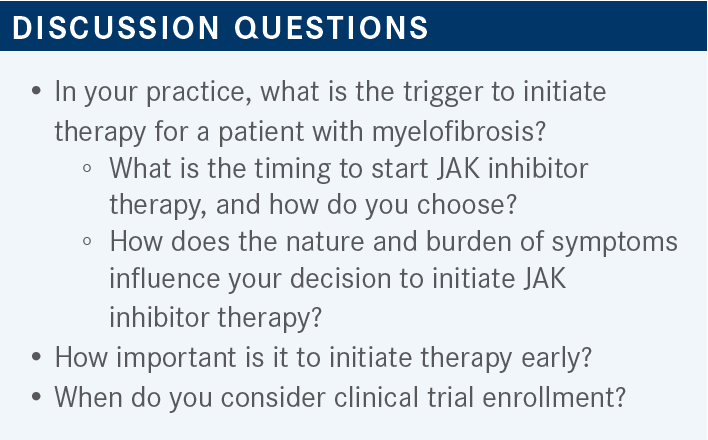Roundtable Discussion: Komrokji Evaluates Pathology, Risk Assessment, and Therapy for Myelofibrosis
During a Targeted Oncology case-based roundtable event, Rami Komrokji, MD, discussed with participants their approach toward assessing and treating a patient with symptoms possibly indicating primary myelofibrosis.

Rami Komrokji, MD (Moderator)
Vice Chair, Department of Malignant Hematology
Head of the Leukemia and MDS Section
Moffitt Cancer Center
Tampa, FL


KOMROKJI: How do you work with your pathologist? It’s a different setting in academia vs [the] community [setting]. How do you work on making the diagnosis? Is it all done by pathology, or [do] you put things together?
NAKKA: I use the hematopathologist for this. You have to put the clinical picture and pathology together to make the diagnosis. But with my clinical practice being oncology, I don’t feel comfortable or don’t have the time to look [at] the pathology, so I use them a lot.
KOMROKJI: That’s the case in most places; we rely heavily on the hematopathology. It is the same here at Moffitt [Cancer Center]. In our [center], the records are different; the cytogenetic [results] come alone, the molecular results come alone, [and] we have to put them together. But in many places the hematopathologists put all those things together for you. Are there any challenges that you face with the myelofibrosis diagnosis?
YELLU: I’m from Florida Cancer Specialists & Research Institute. When we do an in-house bone marrow biopsy, we usually have a hematopathologist do the diagnosis and the cytogenetic studies and whatever is necessary. But if it goes outside the facility, some of them are read by pathologists, and they may have a morphological diagnosis, but we need to request [additional] work-up if there is suspicion for myelofibrosis.
KOMROKJI: Your [hematopathologist] does a good job in putting things together. The concordance in reviewing the bone marrow [biopsy results] is very high. Sometimes we have a little discordance in reviewing the molecular [results]; the thresholds to call mutations are a little different. But your [hematopathologist] does a good job putting all the elements together. Sometimes we try not to repeat the bone marrow [biopsy] here; we request the slides and review them, and the concordance is high.
Once you establish diagnosis, do you use any risk assessment tool in real life? I know this is challenging. I spent time in the clinic, calculating all those risk models for the patients. How do you assess the risk of the disease? Do you calculate any of those [models], or is it [based on your] experience and knowing what is good and bad and not following a formal risk assessment? Does the hematopathologist include risk assessment? I know [for myelodysplastic syndrome] they do sometimes; they include the Revised International Prognostic Scoring System [IPSS-R assessment]. Do you get this information from the hematopathologist?
YELLU: Usually we don’t.
NAKKA: I don’t.
GLICK: No.
KOMROKJI: I noticed that more IPSS-R [assessments] are calculated, but the myelofibrosis [risk assessments] are not, usually.

KOMROKJI: I see that some [participants] use the clinical [assessments]: IPSS/DIPSS [Dynamic International Prognostic Scoring System], DIPSS-plus. One-third are using the [Mutation-Enhanced International Prognostic Scoring System (MIPSS70)]. I usually do a combination…it’s impossible to memorize those, so at least the MIPSS70 and MIPSS70-plus are online. You can calculate quickly. Some physicians rely more heavily on the clinical ones like the IPSS and DIPSS, and some physicians use the molecular ones.

KOMROKJI: Which [tools] do you use? How practical is this in practice? Once you do the evaluation, what do you think is the percentage of patients [at] higher risk in your practice? Maybe somebody can walk me through that. Is this practical in busy practices? How do you assess the risk of the disease?
VATTIGUNTA-GOPAL: I basically follow the criteria, look at the guidelines, and try to assess where the patient falls in low-, intermediate-, or high-risk disease. [If a patient has] high-risk [disease], that’s when we send the patient to [academic centers] for your opinion. We try to put the patients in risk stratification, see where they fall, and follow the guidelines. That’s what I do in my practice, because it’s not a lot of patients we see on an everyday basis.
KOMROKJI: Do [you] use the National Comprehensive Cancer Network [NCCN] guidelines?1 Is that the most common [thing] to [use]?
VATTIGUNTA-GOPAL: Yes, I try to use the NCCN guidelines first, but I also use UpToDate, which we can look at simultaneously because it’s built into OncoEMR. That helps us have up-to-date guidelines of what’s going on with myeloproliferative diseases.

KOMROKJI: How do you start treatment? Do you think there is a role for early initiation of treatment for patients?
VINARSKY: Most of us will start treatment early, because most patients with myelofibrosis, unless they are [at very] low risk, tend to [be] symptomatic rather quickly, with early satiety, left quadrant pain, and such. Once you have a hemoglobin level dropping to less than 11 g/dL or 10 g/dL and a platelet count dropping to less than 100 × 109/L, you have every justification to start treatment. If you have high-risk disease, you’re obligated to do something, because then you’re trying to prevent transformation to AML [acute myeloid leukemia]. But generally, it’s a combination of following blood counts, symptoms correlating to splenomegaly, and other typical symptoms related to myelofibrosis, such as aquagenic pruritis, aches and pains, and other things like this— [symptoms of the] inflammatory cytokine–mediated process.
KOMROKJI: I think the risk of disease is probably the only thing we [consider when] thinking of stem cell transplant [SCT] for those patients. But it’s symptom driven, as you said, mediated by the inflammatory changes. I think of patients in 2 categories: the ones who have constitutional symptoms— splenomegaly-driven symptoms mostly—and [those with] cytopenia. Nowadays, they even describe different molecular and [phenotypic profiles] of those patients. So you have a group who are predominantly symptomatic, with profound fatigue, [discordance] from blood counts, [and] big spleens, and you have a group who [have cytopenia].
The toughest [situation] is when you have a low blood count in somebody who’s symptomatic, but your point is well taken. For many of those patients, because of the burden of the disease, the decision to start the treatment is not just based on the disease risk. Many of the patients in the lower-risk category would require treatment. The presence of symptoms puts them automatically in the intermediate-1–risk category, [although] they are still in the lower-risk category, and that’s the number 1 indication to treat. Unfortunately, other than SCT, many of the options we have indirectly [affect] the survival for those patients, but they don’t necessarily change the natural history of the disease for those patients.
VINARSKY: Do you have a small percentage of patients in your practice with low-risk features that you may choose to observe under certain circumstances, or [do you] usually start treatment by default?
KOMROKJI: That’s an excellent question. We do [the former]. It’s a small number. It’s probably 10% to 20%. They tend to be younger, with completely normal blood counts, and they are asymptomatic. The risk of SCT outweighs the benefit for those patients, so we observe them. If we have trials [available, we] see [whether] we can alter the natural history [of the disease]. Sometimes that’s where, if I’m going to use interferon in myelofibrosis, I will do it to try to change the natural history. But it’s a very small number of patients. We have been trying to look at whether we can [better identify] those [patients who should be observed]. [For example, we will look at whether] patients had more or less than 3 years of treatment without progression.
Going back to our patient, she meets [the criteria for a] diagnosis of primary myelofibrosis. She does have some higher-risk features like anemia, [peripheral blood] blasts, and leukocytosis.

KOMROKJI: How would you treat this patient? [I think it is reasonable to] start ruxolitinib [Jakafi] and refer to SCT or to go [directly] to SCT. Most of the time, if patients are symptomatic, the SCT is going to take some time, and it’s probably reasonable to start ruxolitinib. In the past, if patients [experienced debilitation] from the symptoms of the disease, we could not [perform an SCT for] those patients because of their poor performance [status].
We can start JAK2 inhibitors [first] and then take them to SCT. I think everybody is very familiar with ruxolitinib now. We’ve had it for many years. In the past few years, we’ve had 2 new drugs: fedratinib [Inrebic] and pacritinib [Vonjo]. And there will probably be a third one coming: momelotinib. So we’ll have 4 JAK2 inhibitors approved for patients with myelofibrosis.
I think both approaches [ruxolitinib plus SCT or SCT alone] are reasonable. If the patient is not very symptomatic and the SCT is ready, we could make the argument to take them to SCT directly. But if the SCT is going to take some time and this patient is symptomatic with fatigue and abdominal pain, I think treating with ruxolitinib and going to SCT is reasonable. There were retrospective studies that showed if patients were on ruxolitinib prior to SCT and had some spleen reduction and symptom improvement, they did better with SCT, probably because of better performance [status] and engraftment [From the Data2].


KOMROKJI: In practice, what has been your observation? How do you monitor both response to treatment and the adverse events [AEs] for those patients?
NAKKA: Basically, you look at control of symptoms such as early satiety and weight gain. I usually do a baseline ultrasound, and maybe 3 months into [treatment] I do another ultrasound to check whether the splenomegaly has improved. And I do follow-up ultrasounds as needed.
KOMROKJI: That’s very reasonable. Sometimes I just go by exam. I think the timing you suggest is very reasonable as well: [to do an ultrasound] at 3 or 4 months when you’re going to expect some spleen response. Symptoms like itching and drenching night sweats probably go away within a couple of weeks. In terms of the cytopenia, the nadir is going to be around week 8, so it’s reasonable to bring those patients [in] more frequently at the beginning. Once you get to the third or fourth month, you have a good sense of the AEs, and you can space their appointments [out] a little more. One thing we [have found is] that if those patients get sick and get hospitalized, they ideally should not stop the JAK2 inhibitors, because they get cytokine rebound quickly. For example, if a patient is admitted for pneumonia and they’re on JAK2 inhibitors [and] can take the medication, they should. When patients get sick and are intubated, they cannot take medications, so we [use] bridge [therapy] with steroids. In the setting of an acute infection with cytokine storm, patients can get sick, and if we are stopping those medications, particularly ruxolitinib, we taper those off. We don’t stop them immediately, particularly if the patient had some response.
REFERENCES
1. NCCN. Clinical Practice Guidelines in Oncology. Myeloproliferative neoplasms, version 3.2022. Accessed November 21, 2022. https://bit. ly/2E77tIB
2. Kröger N, Sbianchi G, Sirait T, et al. Impact of prior JAK-inhibitor therapy with ruxolitinib on outcome after allogeneic hematopoietic stem cell transplantation for myelofibrosis: a study of the CMWP of EBMT. Leukemia. 2021;35(12):3551-3560. doi:10.1038/s41375-021-01276-4

Bispecific Antibodies and ADCs Deliver a Futuristic Horizon Across Lung Cancer Settings
October 23rd 2024Recent advancements in protein engineering, especially antibody-drug conjugates, show promise in lung cancer treatment, with ivonescimab outperforming pembrolizumab in PD-L1-positive advanced non-small cell lung cancer.
Read More